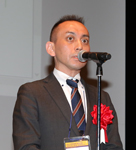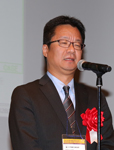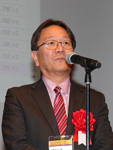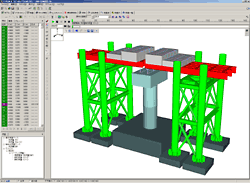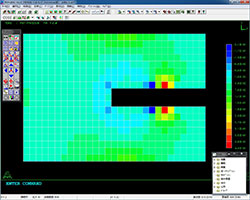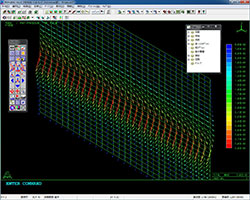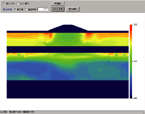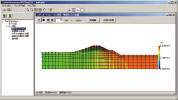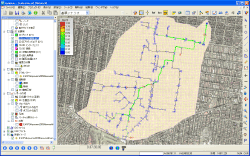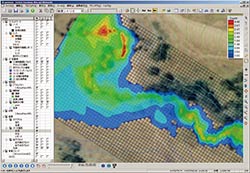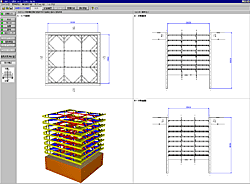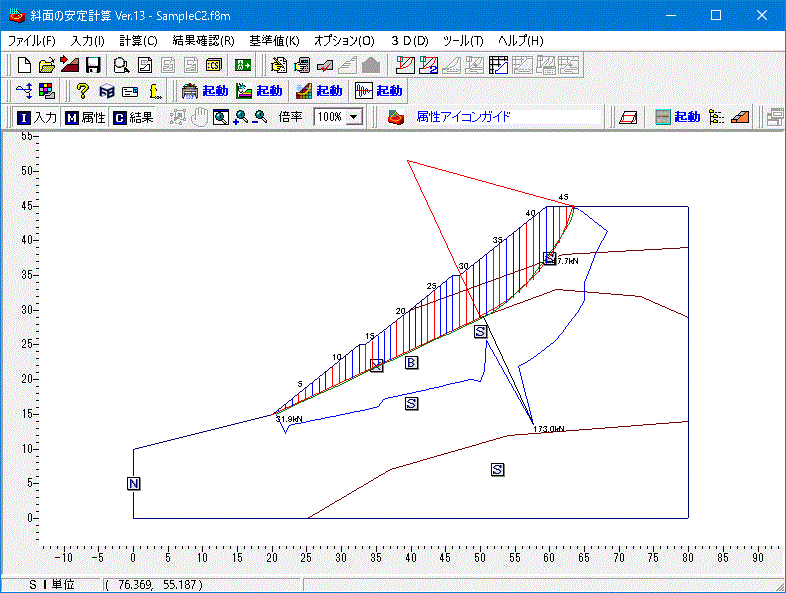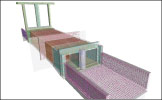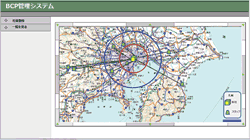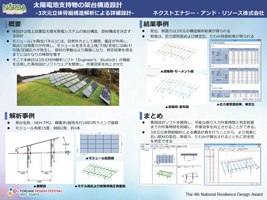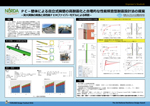| |
The 5th National Resilience Design Award Results Announcement |
After careful consideration by juries, Grand Prix, Semi Grand Prix, and
3 Judge's prizes have been selected.
|
Applying the residual strength evaluation method using degradation level
check to jetties
- Proposal of a new strength evaluation method using a loading experiment
and general regular check results -
Institute of Technology, PENTA-OCEAN CONSTRUCTION CO., LTD. |
|
|
| Program: Engineer's Studio® |
|
|
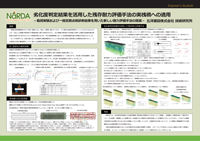 |
 |
Poster PDF(1,272KB) |
|
| Among harbor structures, jetties are especially in severe environments
against salt damage and need more appropriate maintenance than other structures.
However, there are not so many studies on residual strength and seismic
performance of degenerate jetties. In addition, an evaluation of jetties'
remaining strength normally requires a detailed constant check and diagnosis
that takes a lot of cost and time. That is why companies need simple strength
evaluation methods. This research is an suggestion of a simple residual
strength evaluation method that performs a loading experiment for each
degradation level to reveal the relationship between the degree of degeneration
and the remaining strength and export the results to general structure
analysis software programs. |
|
 |
|
2nd Prize |
|
Seismic performance evaluation according to damage on material
- Proposing a reasonable shear strength evaluation method for underground
structures -
Knowledge Fusion Co.,Ltd. |
|
|
| Program: WCOMD Studio |
|
|
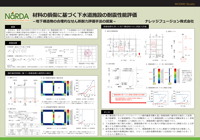 |
 |
Poster PDF(1,535KB) |
|
This work proposes a reasonable shear strength evaluation method for underground structure of sewage facilities by using a damage indicator that does not depend on the element dimension or material physical model. After considering the applicability of damage indicator on the basis of a static load experiment for an underground box culvert, shear strength against underground walls of sewage facility was evaluated. The work found that it can execute a more reasonable evaluation than the current evaluation using shear strength.
|
|
|
| Honorable Judge Award |
Prof. Hiromichi Yoshikawa (Chief of the judging committee)
Professor Emeritus, Tokyo City University |
|
Stress analysis on the branch point of steel deck box girder bridge
- Stereoscopic FEM model analysis by using plate and shell -
KATAHIRA & ENGINEERS INC. |
|
|
| Program: FEMLEEG |
|
|
 |
 |
Poster PDF(1,143KB) |
|
| Although the dynamic analysis by frame is already done for the analysis target bridge, it is estimated that the stress will focus on the branch point because of the special structure that separates on the intermediate fulcrum. If this part is seriously damaged, it will take a lot of time to restore the bridge, and that may block a passage of emergency vehicles. In this work, a stereoscopic analysis model using plate and shell was created for more detailed analysis. |
|
 |
| Honorable Judge Award |
Prof. Masaru Morita, Vice-president of Shibaura Institute of Technology
Professor of Urban Environmental Engineering Laboratory,
Civil Engineering Department, Shibaura Institute of Technology |
|
CFD analysis simulation of traditional architecture
- Wind speed analysis outside "Futatsuya" -
Kagoshima University |
|
|
| Program: DesignBuilder |
|
|
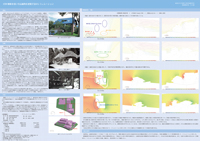 |
 |
Poster PDF(987KB) |
|
| This is a simulation using the CFD analysis for houses being constructed
in Kagoshima city. This house is modeled on the "Futatsuya" that
is a traditional house constructed widely in Southern Kyushu district.
By focusing on the Futatsuya house model and the wind blowing around, this
simulation performed by modern technologies tests and analyzes the effectiveness
of traditional residences rooted in the region based on wisdom and experience
cultivated in the era with undeveloped technology. |
|
 |
| Honorable Judge Award |
Prof. Akihiko Wakai
Professor of Science and Engineering Department, Gunma University |
|
Seismic performance verification for PC snow shed against L2 earthquake
- Towards making a snow shed to withstand a large earthquake -
NIHON SAMICON CO., LTD. |
|
|
| Program: Engineer's Studio® |
|
|
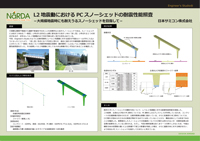 |
 |
Poster PDF(910KB) |
|
| A snow shed is the best method to protect roads and railroads from large
fallen snow and snowslide. So far, the seismic method against the L1 earthquake
has been used for the seismic design of snow shed. Because of the revision
of the standards, however, an need for designs against L2 earthquake is
increasing. The seismic performance test by non-linear time history response
analysis (dynamic analysis) is executed in lateral direction that has more
strict conditions to check the safety at L2 earthquake. |
|
|
Seismic verification of coastal embankment
- Liquefaction determination and seismic deformation analysis against structure
-
Cosmo Consultants Co., Ltd |
|
|
| Program: GeoFEAS 2D |
| This is a review of coastal embankment in Southern Kyushu region at earthquake.
After evaluating the liquefaction of the ground, the stability of structures
at L1 earthquake was checked. The deformation amount was estimated by the
static varification method, and the seismic performance was also evaluated.
As a result, the deformation amount at liquefaction was determined to be
within the allowable value. |
|
|
Seismic performance verification for additional piles against L2 earthquake
and tsunami
- Frame analysis against additional pile foundation of coastal levee -
Marine Support Engineering |
|
|
| Program: Engineer's Studio® |
| Piles (cast-in-place pile dia.1000) were added to the existing coastal
levee foundation (steel pipe pile dia. 1000) since the support force was
not enough. When the bottom slab length becomes longer due to additional
piles, the thickness of the current bottom slab cannot be thicker. The
bottom slab cannot be considered as a rigid, and it requires a frame analysis
test considering its rigidity. The review was done with models with rigid
bottom slab, and the test against level 2 earthquake and tsunami load which
foundation test results are strict was executed by using Engineer's Studio®. |
|
|
Seismic test for a steel intake tower
- Interaction between a steel tower and a multistage telescope type cylinder
gate at earthquake -
APPLIED TECHNOLOGY CO., LTD. |
|
|
| Program: Engineer's Studio® |
| The multistage telescope type cylinder gate is mainly used for the water
withdrawal at dam. Its elastic door mechanism according to the water height
in dam enables the stable continuous water withdrawal from the entrance
on the top. The gate is separated from the tower around them, and it causes
complex movements of the door and tower powered by suspending rope and
guide roller. In this work, the suspending rope is modeled with a cable
element and the guide roller with a spring element, and the seismic test
is executed by a time history response analysis considering the interection
between the gate and tower. |
|
|
Evaluating damage on existing bridge foundation caused by L2 earthquake
- Evaluation of existing foundation by pushover analysis focused on the
displacement sudden increase point -
Wakasuzu Co., Ltd. |
|
|
| Program: Pier 3D bar arrangement, Foundation 3D bar arrangement |
| The Specifications for Highway Bridges (March 2012) says that the standard
foundation yield is a condition either "all piles have plastic body"
or "the pile head reaction of one column reaches the limit of press
bearing capacity". However, these conditions do not always match the
displacement explosion point at inertia action position of superstructure.
Sometimes the horizontal strength is kept even after becoming these conditions.
This work is a calculation of plasticity rate of the existing pier foundation
by executing a pushover analysis gradually increasing the horizontal seismic
intensity on foundation piles by 0.01 and determining the foundation yield
horizontal seismic intensity (khyF) of foundation from the displacement
explosion point in each model. |
|
 |
 |
 Meeting for selecting nomination works Meeting for selecting nomination works
at Seminar Room in FORUM8 Head Office |
 Juries (From left) Mr. Akihiko Wakai, Juries (From left) Mr. Akihiko Wakai,
Mr. Hiromichi Yoshikawa (Chief of the judging committee),
Mr. Masaru Morita |
 |
|
■Grand Prix |
|
■Excellence Award |
|
■Honorable Judge Award |
|
■Nomination Award |

 |
Certificate / Trophy /
Raytrek high performance
notebook / Portable SSD
Amazon gift card |
|
Diginnos mobile notebook /
Certificate /
AMAZON gift card |
|
Action cam GoPro
session (for 4K30 video)
Certificate /
Amazon gift card |
|
Plaque / Amazon gift card |
| PCs provided by Thirdwave Corporation |
*No dual recipients |
| |
Profile of Judging Committee |
 |
Prof. Hiromichi Yoshikawa (Chief of the judging committee)
Professor Emeritus, Tokyo City University
Visiting professor of Colorado University (1992-93). Graduated from Department
of Science and Engineering.
A doctor of civil engineering and a specialist of aseismic engineering,
earthquake risk, and armored concrete.
Won the literature award and Yoshida award of Japan Society of Civil Engineers.
Author of some books. |
 |
Prof. Masaru Morita
Vice-president of Shibaura Institute of Technology
Professor of Urban Environmental Engineering Laboratory, Civil Engineering
Department, Shibaura Institute of Technology
Professor of Department of Civil Engineering, Shibaura Institute of Technology.
Specialist of urban hydrology and groundwater hydrology. Currently he researches
risk management of a flood.
The author of a book about groundwater. |
 |
Prof. Akihiko Wakai
Professor of Science and Engineering Department, Gunma University
Member of Department of Environmental Engineering Science of Gunma University.
He studies in a disaster prevention of ground, various ground movement,
and interaction between ground and a structure, especially focus on a prediction
by computers like FEM. |
Flow of the contest
| Tue. 9 Oct. 2018 Deadline for works submission |
| Wed. 17 Oct. 2018 Meeting for selecting nomination works |
| Tue. 13 Nov. 2018 Examining Meeting at FORUM8 Tokyo head office MAP |
Fri. 16 Nov. 2018 SHINAGAWA INTERCITY Hall
Award Ceremony of the 5th National Resilience Design Award |
Overview of application
| Deadline for works submission |
Tue. 9 Oct. 2018 |
| Application standard and Deliverable |
Contents including not only design and analysis, but also comment on disaster
reduction, reasonable design method, BCP, and risk management that help
to strengthen the national land directly or indirectly are accepted.
Mandatory
- Work title / sub title (about 30 words)
- Work overview (about 150 words)
- Poster: A1 horizontal, Purpose and contents are clearly described.
- Report (purpose, method, result, consideration): 3 or 4 pieces of A4 paper
- Input data (Result file)
- Product name
Optionally
- Animation, movie
- PPT
Language
|
| Where to deliver the data |
Please tell your contact person of FORUM8 staff and send it to him/her. |
| Copyright |
All contents of the work data are the copyright of each applicants.
The submitted data will not be distributed, but FORUM8 has a right to use
the data and works, edit and reproduce the images and videos etc. and post
or introduce it on website, magazines, books, and newspaper. as a sales
activity or an advertisement as a secondary user of data. Please be forewarned. |
| Inquiries for the application |
Please tell your contact person of FORUM8 staff. |
Meeting for selecting
nomination works |
Nominated works will be decided on Wed. October 17, 2018.
Meeting for selecting nomination works on Wed. October 17, 2018 |
Usable Product
FEM Analysis
UC-1 series
- Structural analysis, bridge superstructure, bridge substructure, foundation
design, temporary work design, road work design, water work design
Others
Analysis Support Service
|
|


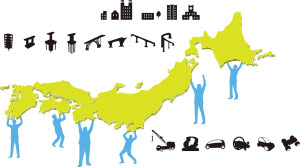


 Meeting for selecting nomination works
Meeting for selecting nomination works Juries (From left) Mr. Akihiko Wakai,
Juries (From left) Mr. Akihiko Wakai, 











